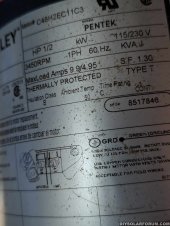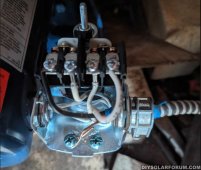Davester
New Member
I know watts is amps multiplied by volts. I'm hoping to spec my first inverter large enough to power my deep well pump.
Here is my confusion. and the label says...
115/230 volt
MaxLoad Amps 9.9 / 4.95
Why the 2 voltages? Am I assuming correctly that the MaxLoad amps are 9.9 on 115volt and 4.95 on 230volt?
I'm attaching a photo of the label and the wires entering the relay. I'm assuming 2 of the 4 wires are power in at 110/120 volt, and two wires out of the relay are 11/120 volt as well.
9.9 times 115 = 1138.5 watts
I know initial draw on startup is high so I have to over-spec. Will a 2000-watt inverter suffice? 3000-watt?
Thanks for any advice. Want to be prepared for hurricane season. When we lose power it can be down for weeks. This isn't for a permanent set-up, but rather for grid down situations.
Any advice would be appreciated.
Thank you.
Here is my confusion. and the label says...
115/230 volt
MaxLoad Amps 9.9 / 4.95
Why the 2 voltages? Am I assuming correctly that the MaxLoad amps are 9.9 on 115volt and 4.95 on 230volt?
I'm attaching a photo of the label and the wires entering the relay. I'm assuming 2 of the 4 wires are power in at 110/120 volt, and two wires out of the relay are 11/120 volt as well.
9.9 times 115 = 1138.5 watts
I know initial draw on startup is high so I have to over-spec. Will a 2000-watt inverter suffice? 3000-watt?
Thanks for any advice. Want to be prepared for hurricane season. When we lose power it can be down for weeks. This isn't for a permanent set-up, but rather for grid down situations.
Any advice would be appreciated.
Thank you.





